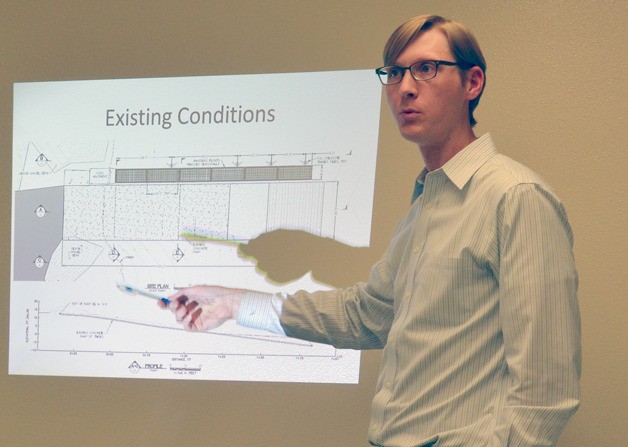Port of South Whidbey Commissioners informally agreed on the scope of the Possession Beach boat ramp revamp project Tuesday, May 13.
Joel Darnell, an engineer with Edmonds-based Coast & Harbor Engineering, presented the board with an update on the renovation project at their regular meeting. After months of reviewing, the firm established three design options, with estimates ranging in cost from $350,000 to $450,000.
Commissioners Ed Halloran and Curt Gordon both preferred the more expensive option, which would replace the 40-foot ramp and move the piles and floats to the south side of the ramp, saying it appeared to offer the best service to users.
“If we’re going to do this we should try to go all the way,” Halloran said.
According to Darnell, the boat ramp is deteriorating, with rebar exposed. The piles and floats near the ramp are also reaching the point of needed repairs. He suggested the floats should be fixed rather than replaced because, despite their current state, they are still more sturdy than new replacements on the market today.
“If, in the future, you want to replace the floats, you want to have pilings that are going to last long enough to get value out of the new floats,” he said. “We’re focused on the ramp and pilings to set the foundation for future repairs that may come down the line. Having a good ramp and good piles is the first step.”
The first design option presented a raised and shorter ramp that would take advantage of the existing end, which is typically buried under sand. The second option replaces the entire 40-foot ramp with poured concrete at the top and pre-cast concrete placed on the end. The third, the one preferred by the commissioners was the most extensive — replacing the ramp and moving the piles, which is believed to aid sediment flow and eventually lower the cost and time of maintenance.
Including the gravel under the concrete and the ramp itself, the design would raise the ramp about 20 inches. The timber pilings in all the options will also be replaced with steel pilings.
Darnell noted these design options are still being tweaked, but estimated the cost difference between the shorter ramp and longer ramp to be about $40,000.
Gordon said if work is already being done on the pilings and concrete, it makes sense to also make the investment on a longer ramp.
Halloran agreed and said the first option of a shorter ramp may make users uncomfortable.
“Having launched there a couple of times myself, I would like to know that something is there for the boater,” he said.
Now that the board’s design preference is clear, the firm will come back to the commissioners with a more detailed cost estimate for option three.
The next regular meeting is scheduled for Tuesday, June 10.



